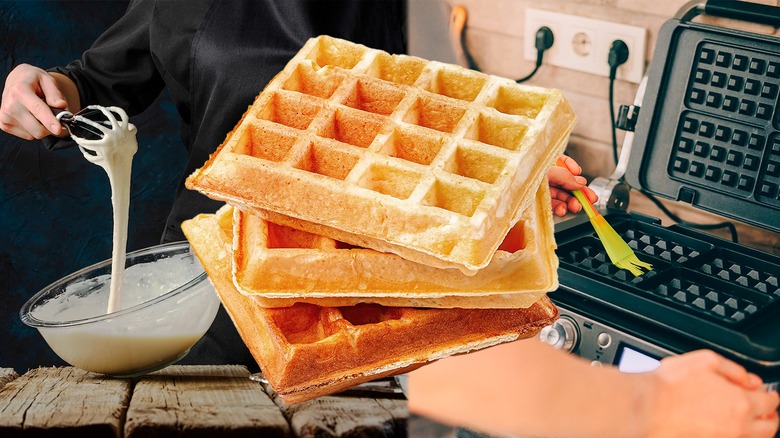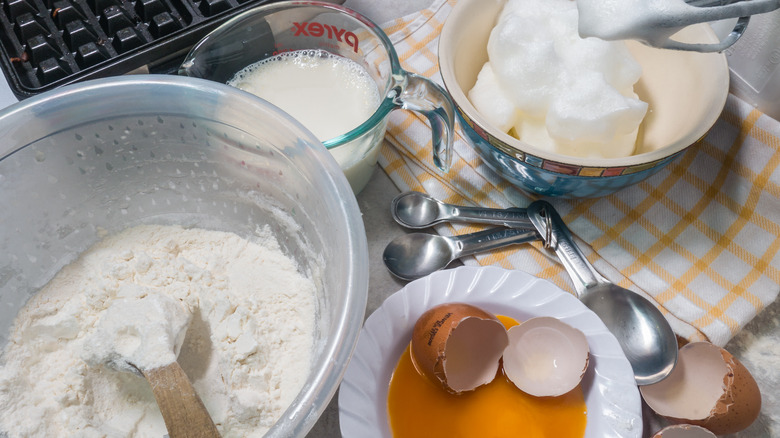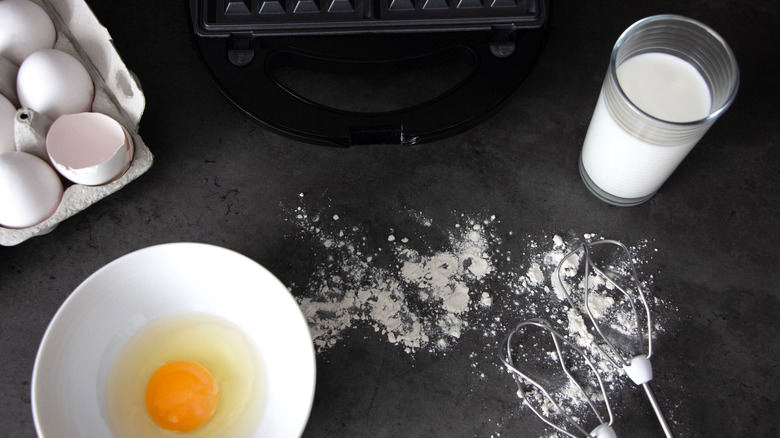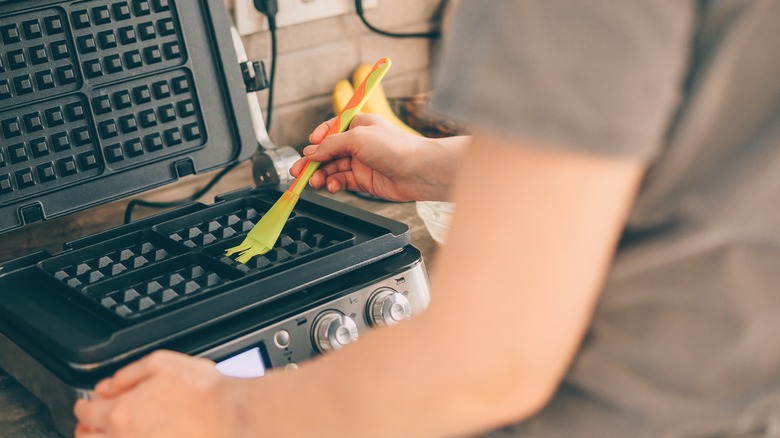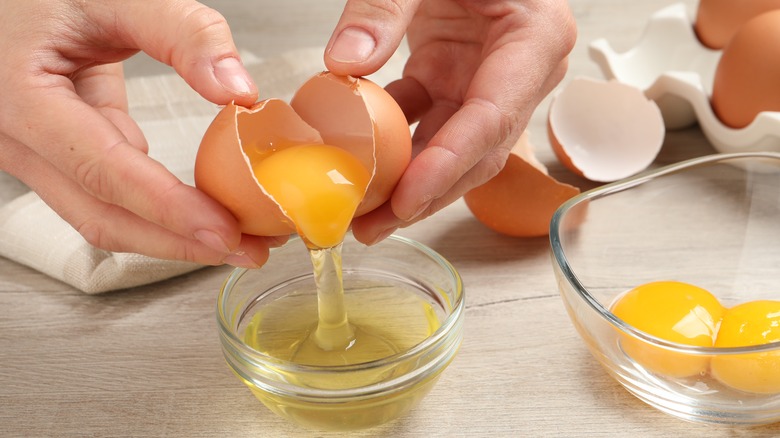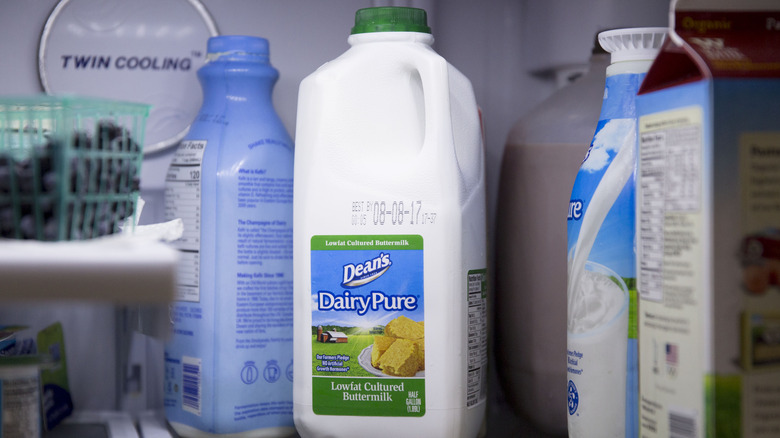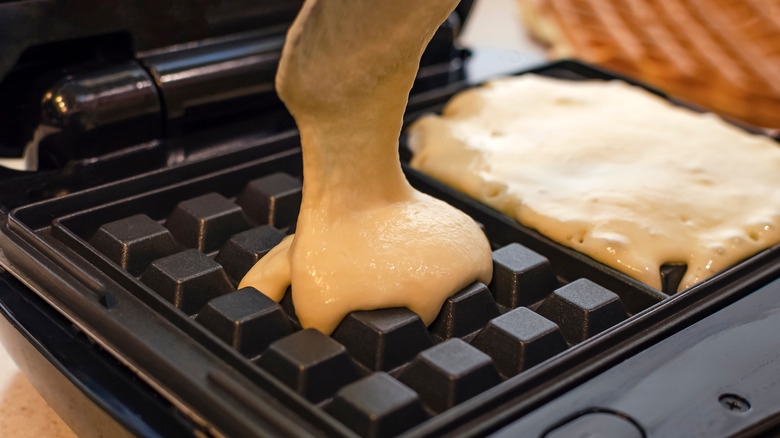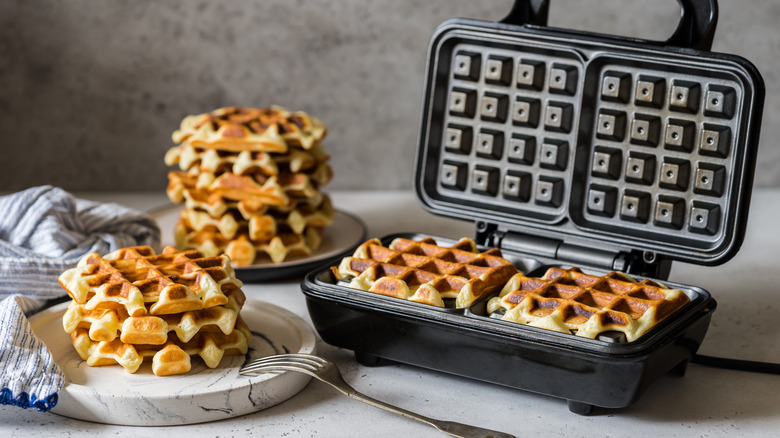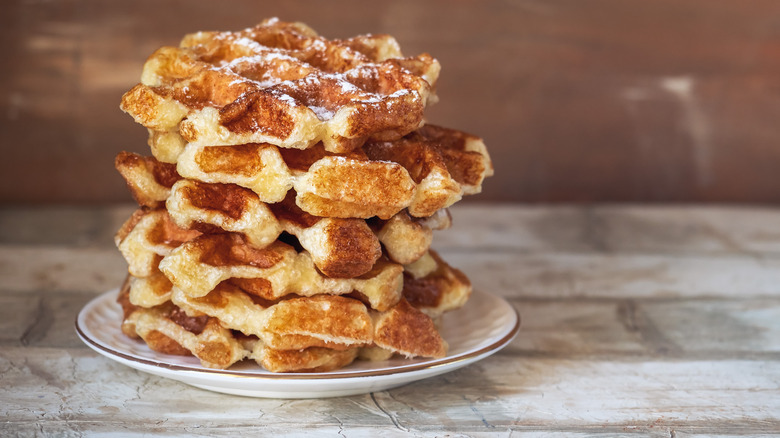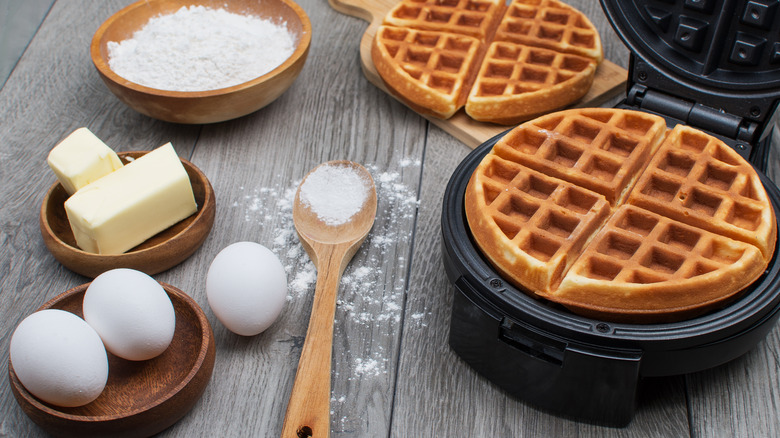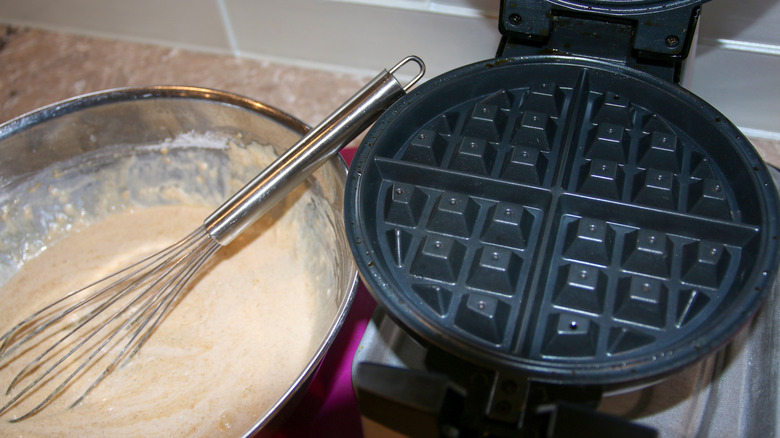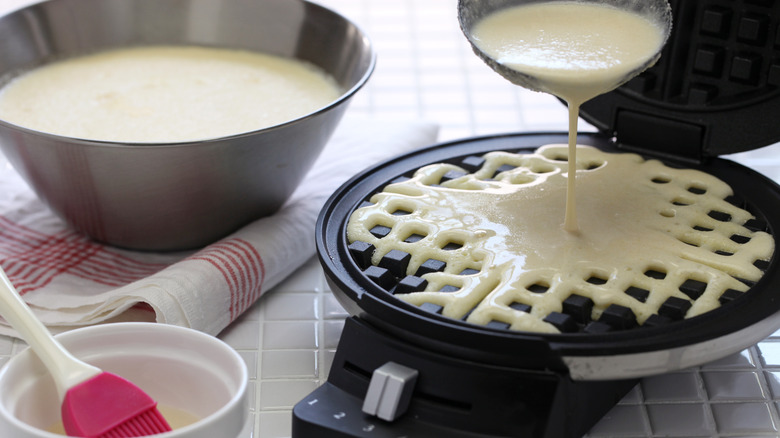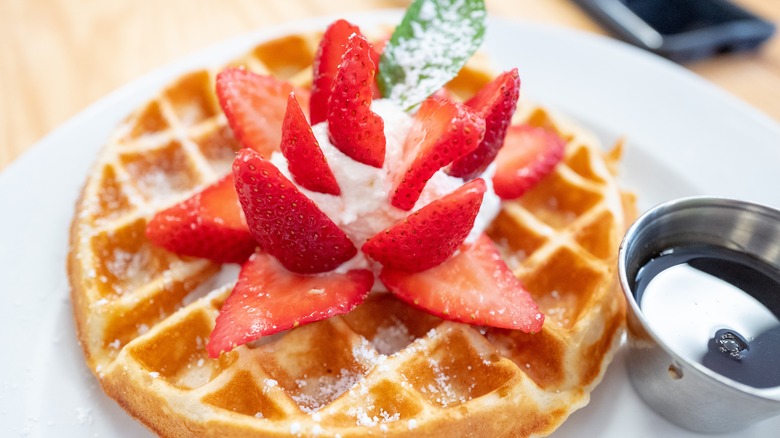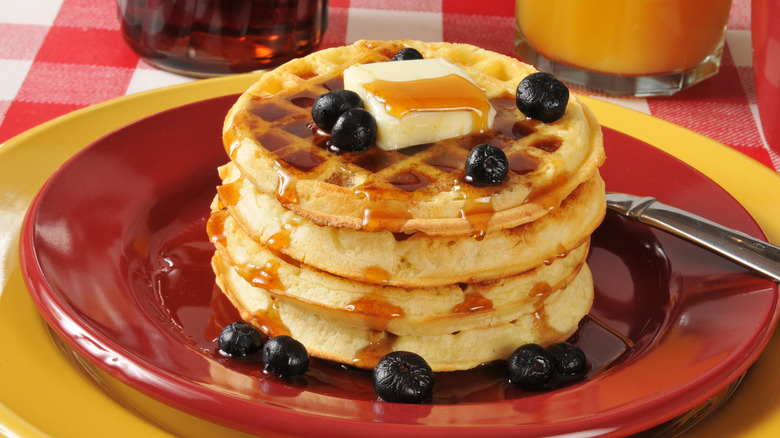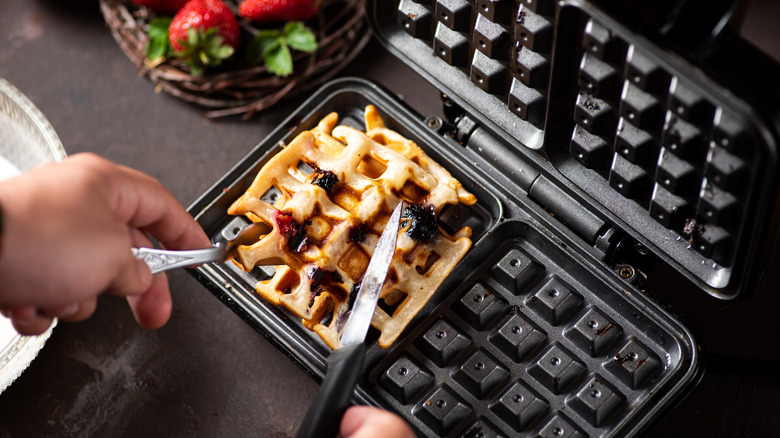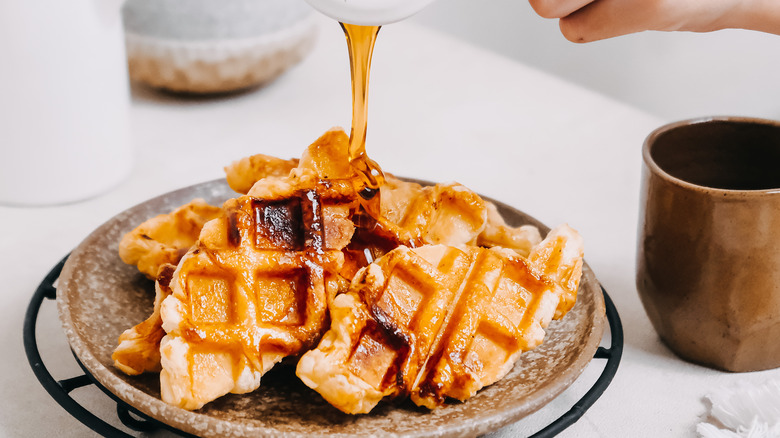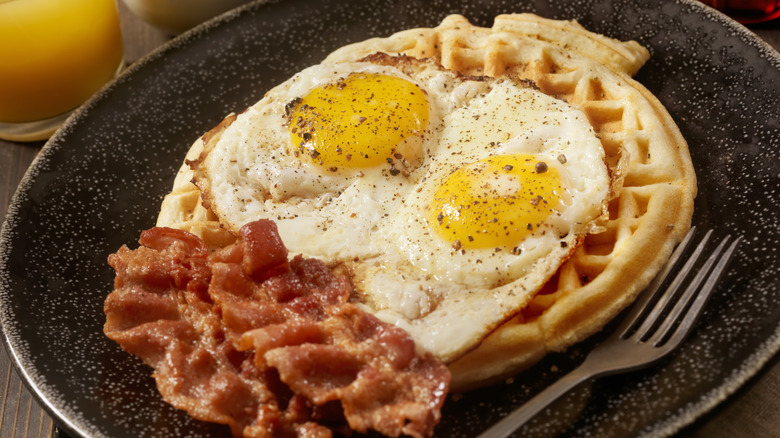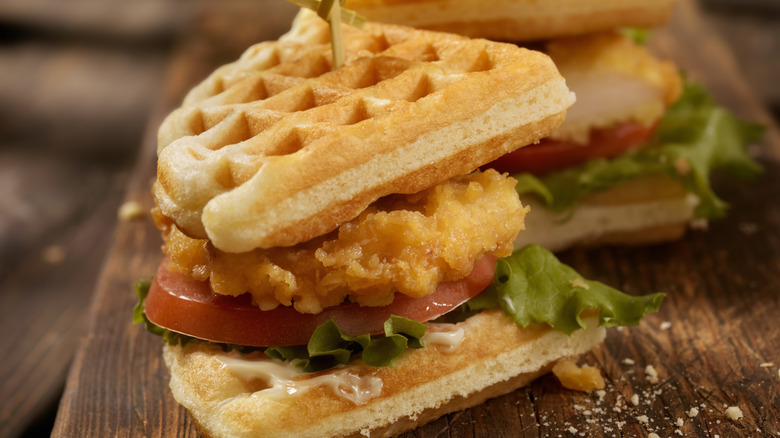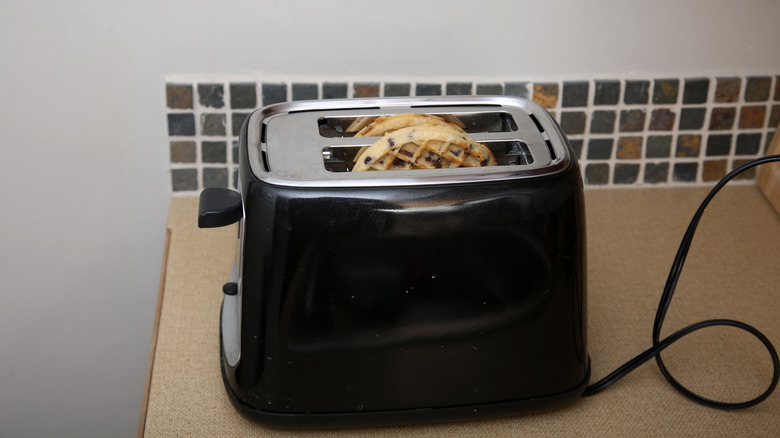19 Common Mistakes To Avoid When Making Waffles
There's something special about waffles that makes them feel like a gourmet breakfast, even though they really aren't that involved to make. Whether you follow an old family recipe to make your waffles from scratch, or you prefer to use a boxed mix, you want the finished product to turn out right.
Unfortunately, there are a lot of things that can stand in your way when it comes to making beautiful and tasty waffles. People make several mistakes which can leave them with burnt waffles, waffles that aren't fully cooked, boring waffles, cold waffles, or waffles with a host of other problems.
If you want to make sure your waffles turn out incredible every time you pull out the waffle iron, don't fret. While common, if you know what to watch out for, these mistakes are easily avoidable. Keep reading to make sure that you don't make the same errors that others have made so that you're able to cook and serve scrumptious waffles to your guests.
1. Making the batter ahead of time
If you're planning a big breakfast and want to make sure you have as much ready to go as possible, it can be tempting to make your waffle batter the night before. However, doing so would be a mistake. If you make your waffle batter ahead of time, it's only going to lead to disappointment when you — and your guests — go to eat the waffles. If the batter sits for too long, the waffles are likely to end up very dense.
The reason for this has to do with the baking soda that is in your waffle mix. When you mix all of the ingredients together, the baking soda and acidic ingredients combine together to create carbon dioxide gas bubbles. If cooked promptly, these bubbles will remain trapped inside the waffle batter, yielding light and airy waffles. However, if the batter sits for too long, all of the air bubbles will escape, leaving you with flatter waffles.
2. Not paying attention to the recipe
Reading is fundamental. You aren't taught to read in school as a child only to throw all that knowledge to the side and assume you know everything as an adult. Recipes are there for a reason, so you need to follow them — whether they are on the side of a box of mix or in your favorite cookbook. In addition to the basic reasons for reading a recipe – such as understanding the proper amount of each ingredient and the order in which to mix everything together — there is another essential reason to read the recipe before you plan to make your waffle batter. That reason has to do with proofing.
While it typically isn't best to mix your batter ahead of time, a few recipes may call for you to do so. This is because some waffle recipes want you to proof yeast and let the batter rise in the refrigerator overnight (or for at least eight hours). If you wait until the morning you want to make the waffles, it will obviously be too late to give the batter time to proof.
3. Not warming the cold ingredients first
When you make waffles, do you warm the milk, buttermilk, or other liquid ingredients before you combine them with the dry ingredients? If you answered no, you've just identified one mistake you've been making. Warming the liquid ingredients will help your waffles turn out better, by making everything easier to mix together. It is going to take much longer for you to get the batter nice and smooth if you're trying to mix cold liquids into the dry ingredients.
If you add melted butter to your waffle batter, that's another reason to warm up the other liquid ingredients. Mixing in cold buttermilk with melted butter can cause the butter to coagulate. Instead of the smooth waffle batter you're aiming for, this can leave you with a very lumpy mixture.
4. Forgetting to grease the waffle iron
Waffle irons are nonstick. They don't need to be greased before adding waffle batter, right? Wrong. Nonstick does not mean that absolutely nothing will stick, it just means that fewer foods will get stuck and that cleanup will be easier. Think about all of the little bumps and grooves along a waffle iron. They present several opportunities for your batter to get stuck as it cooks.
When greasing a waffle iron, opt for either oil or cooking spray. If you choose oil, you can brush it over the iron using a silicone pastry brush. You might think that you should grease the iron with butter, but it isn't a good idea. The butter won't work as you think on the hot iron, and could lead to your waffles getting stuck.
5. Not separating the egg whites and yolks
Here's another important waffle-making step that we bet you are skipping: separating the egg whites from the yolks. This may seem like a waste of time since waffle recipes call for the entire egg, not just the whites or the yolk. However, when you taste the difference, you'll realize that time is anything but wasted.
When you separate the eggs, you can beat the egg whites using your hand mixture until they form stiff peaks. This is the same process you would use when making meringue. Then, mix in the egg yolks and the rest of the ingredients, reserving the egg whites until the end. Finally, fold — don't overmix — the yolks into the batter. Doing so will incorporate more air into your batter, providing you with light, fluffy, and tasty waffles.
6. Using only buttermilk
Buttermilk waffles can taste incredible. However, while adding buttermilk to your waffle batter is a good idea, you might want to reconsider using buttermilk as the only liquid in the recipe. Because of how heavy buttermilk is, it can make the batter a bit too dense, and leave you with dried-out waffles.
Try replacing about one-half of the buttermilk the recipe calls for with standard milk — or even almond or soy milk. By cutting down on the ratio of buttermilk in the recipe, your batter won't be quite so dense, allowing your waffles to turn out fluffier than they would have otherwise.
7. Putting the batter on the waffle maker before it gets hot
Never start scooping your batter onto the waffle maker before it has had a chance to fully preheat. If the waffle iron is too cold, it isn't going to cook the waffles properly. When you put the batter in before the iron has a chance to reach the proper temperature, nothing is going to cook evenly, which can result in under or overcooked waffles.
Similarly, if the waffle maker isn't working properly anymore or heating up to a high enough temperature, you are likely going to end up with dried-out waffles. You'll have to cook the waffles for longer, which will give too much time for the moisture to escape and the waffles to harden. If you suspect that your waffle maker isn't getting as hot as it should, it may be time to purchase a new model.
8. Opening the lid before the waffles are really cooked
Patience is key when it comes to making waffles. You don't want to open the lid to your waffle maker until you're confident that the waffle inside of it has finished cooking. Many waffle makers come equipped with a light that either turns on or off when the waffle has finished cooking. Avoid opening the lid before the light changes, because an uncooked waffle could tear apart or stick to the lid as you open it.
If your waffle maker does not have an indicator light, you should still be able to gauge doneness. Keep an eye on the top of the waffle maker. As the waffle is cooking, there should be a lot of steam rising from the top. Once it has finished cooking, the steam should stop. For most waffle makers, this takes around 5 minutes, but every model is different.
9. Not keeping the waffles warm before serving them
If you're making waffles for a crowd, you want to make sure to keep them warm before they're served. One downside of cooking waffles is that you can only make one at a time unless you have multiple waffle irons. While you're making the second, third, fourth, and other waffles, the ones that have already been cooked are going to get cold if they're sitting out on the counter.
To avoid this problem, preheat your oven to 200 degrees Fahrenheit before you start cooking. Once you take a waffle out of the waffle maker, move it into the oven. The low oven temperature will keep it warm (without burning it) until you're ready to serve breakfast. You could even put the waffles directly onto the oven racks if you want to make them a little crispy.
10. Adding the wrong ratio of ingredients
We've touched on a few reasons why it's essential to pay attention to a recipe when making waffles, but here's another one. If you don't follow the recipe and add the correct ratio of ingredients, your batter could end up overly dense or super thin. Neither of these options is going to yield light and airy waffles.
Adding the right ratio of wet and dry ingredients can help keep your batter at the perfect consistency for making waffles. If you plan on doubling or tripling a recipe to make a larger quantity of batter for a group, make sure you do your math correctly and properly measure out the right amount of each ingredient.
11. Overmixing the batter
Mixing waffle batter is a bit of an art. Many people want to mix it more than is necessary, thinking that they're making it smoother, and thus, making their waffles lighter and fluffier. However, this just isn't how it works. While you do want to mix the batter enough to get rid of any clumps, if you overmix it your waffles aren't going to taste as great as they could.
Overmixing waffle batter can cause the flour to turn into gluten. If this happens, the cooked waffles are going to be less fluffy. Instead of being light and airy to bite into, they'll taste dense and chewy. To properly mix your waffle batter, work gently using a spatula until the ingredients are well-combined and clump-free. Don't whip the spatula around as hard or for as long as you possibly can.
12. Putting the wrong amount of batter in the waffle maker
If you don't add the right amount of batter to the waffle maker, you're going to end up with waffles that are either much smaller than you want, or you're going to be dealing with an overflowing mess on the sides of the waffle maker and all over your counters. Clearly, adding the correct amount of batter is important. However, every waffle maker is different, so there is no one right answer for how much batter you should use to make a waffle.
Some waffle makers come with a batter cup that helps you measure out the ideal amount to make a perfectly-sized waffle. You may also be able to find the manufacturer's recommendations in the product manual. If neither of these options help, do a few experiments with different quantities of batter until you land on the ideal amount. Then, write it down somewhere that you'll be able to find it for the next time you make waffles.
13. Not trying different types of waffles
Not all waffles are the same. There are different styles and thicknesses. If you've only been using the same waffle maker, you may not realize what you've been missing out on. The two main waffle styles are classic and Belgian. Classic waffles are the thinner of the two options. You can find classic waffle makers in various shapes, including round, rectangular, or square. There are also several mini classic waffle makers on the market.
Belgian waffles, on the other hand, are much thicker than classic waffles. Their increased height also means that each of their square-shaped divots is also much deeper, allowing them to hold more buttery and syrupy goodness. There's nothing wrong with sticking with either Belgian or classic waffles, but it is always good to have some variety in your breakfast rotation.
14. Not experimenting with different add-ins
Plain waffles are just fine. But, again, variety is the spice of life, and it is always fun to experiment with different add-ins that will change the taste and texture of your waffles. Trying different add-ins can help keep you from getting tired of eating waffles, because each day will present an opportunity to try something new and delicious.
There are several add-in options for waffles. You can probably think of a few new ideas yourself once you find the inspiration. Some of the most popular include blueberries, strawberries, chocolate chips, and bacon. You could also experiment by changing the overall flavor of the batter, by mixing in some cocoa powder to make chocolate waffles, peanut butter to make peanut butter waffles, or vanilla extract to make vanilla waffles. You're only limited by your imagination and your taste buds.
15. Using metal utensils with the waffle maker
As mentioned above, waffle makers have a nonstick coating. Because of this, it is important to be selective about which utensils you use when cooking your waffles. Opt for silicone, nylon, or wooden utensils to avoid scratching the waffle maker.
You should not use metal utensils with your waffle maker as they could scratch the surface. This can cause the coating to flake off. You could end up eating some of it along with your waffle, which can't be good. Moreover, as the coating flakes off, it will affect the nonstick surface of the waffle maker. In the future, your waffles could start sticking more, making cleaning the waffle iron up more difficult.
16. Forgetting the syrup
Syrup and waffles go hand-in-hand. If you're serving waffles to friends or family, it would be a huge mistake to skip the syrup. Someone is going to be looking for it and disappointed to find out it's not available. Don't forget to pick up a bottle of syrup from the grocery store before your breakfast get-together.
If you don't want to serve syrup, or you want to have a few alternatives for people who might not like it, there are several options to consider. Try molasses, honey, agave nectar, nut butter, or sugared fruits. Any of these will give your waffles a unique taste, so think about the flavor profile you're going for.
17. Not serving them alongside other sides and entrees to make a complete breakfast
As tasty as they are, waffles alone do not make a complete breakfast. When you're planning a breakfast with waffles, put some thought into the other items you'll want to serve alongside the waffles. Eggs and bacon or sausage are classic options, but they aren't the only options out there. You could also consider serving your waffles with some fresh berries and whipped cream, hash browns, breakfast potatoes, yogurt, or any of your other favorite breakfast side dishes.
Once you've decided what you want to serve with the waffles, you'll need to come up with a plan to have everything ready at the same time. Think about how long the different parts of the meal each take to cook, and when you want to serve breakfast. Then, you can work backward to decide when each item should be started.
18. Only serving them for breakfast
Waffles may be most traditionally associated with breakfast, but that doesn't mean that you can only serve them for this particular meal. In fact, there are many lunch or dinner recipes that feature waffles. Chicken and waffles is one of the most popular options you'll see, although it may also be a breakfast choice on some menus. Crispy fried chicken or chicken tenders pair so nicely with a soft and warm waffle. Beyond chicken and waffles, you could use waffles in place of a hamburger bun, make mini waffle pizzas, use a waffle in place of a tortilla or pita for a taco or wrap, or make a waffle quesadilla.
This carbohydrate can also make a tasty dessert when paired with the right ingredients. Consider serving a scoop of ice cream drizzled with chocolate over a warm waffle for a real treat. You could also add some cocoa powder to your waffle batter to make a chocolate waffle.
19. Not freezing the leftover waffles
Sometimes your eyes are bigger than your stomach, and you end up making more waffles than you could possibly eat. Other times, you may end up misjudging exactly how much batter you'll need to serve your breakfast guests. In times like these when you are left with extra waffles, don't let them go to waste. If you don't think you'll be able to eat them within the next few days, you can freeze them for a future breakfast.
Fortunately, waffles are easy to freeze. Start by placing your extra waffles in a single layer on a baking sheet (you may need to use multiple sheets or repeat the steps if you have a lot of waffles). Place the baking sheet in your freezer for 1 and a half to 2 and a half hours, or until the waffles are frozen. Then, you can remove the waffles from the baking sheet and stack them in a freezer-safe plastic bag. Place a piece of parchment paper between each waffle to keep them from sticking together, seal the bag, and put it in your freezer. Whenever you want a waffle, just pull one out and pop it in the toaster or air fryer.
